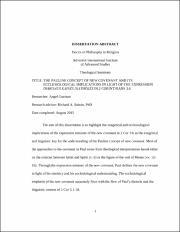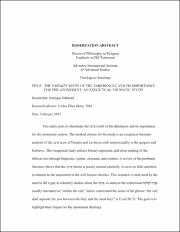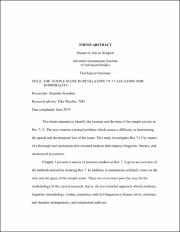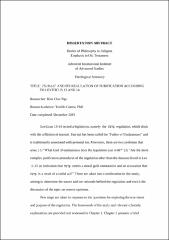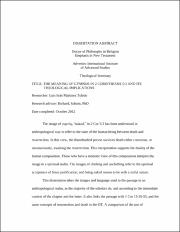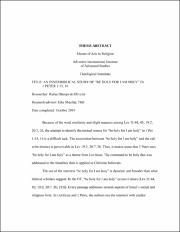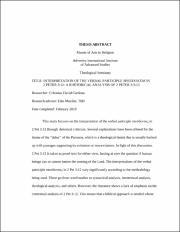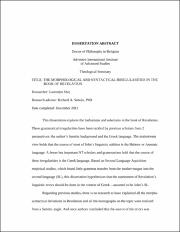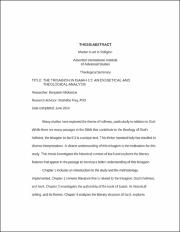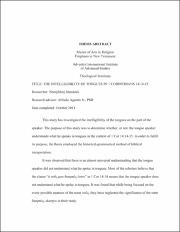Search
Now showing items 31-40 of 45
The Pauline concept of new covenant and its ecclesiological implications in light of the expression Diakonus Kaines Diathekes in 2 Corinthians 3:6
(Adventist International Institute of Advanced Studies, 2015-08)
The aim of this dissertation is to highlight the exegetical and ecclesiological implications of the expression minister of the new covenant in 2 Cor 3:6 as the exegetical and linguistic key for the understanding of the ...
The PAROKET motif of the tabernacle and its importance for the atonement : an exegetical-thematic study
(Adventist International Institute of Advanced Studies, 2015-02)
This study aims to illuminate the פָּרכֶֹת motif of the tabernacle and its importance
for the atonement system. The method chosen for the study is an exegetical-thematic
analysis of the פָּרכֶֹת texts of Exodus and ...
The Temple scene in Revelation 7:9-17 : location and temporality
(Adventist International Institute of Advanced Studies, 2019-06)
This thesis attempts to identify the location and the time of the temple service in
Rev 7:15. The text contains a textual problem which causes a difficulty in determining
the spatial and the temporal loci of the scene. ...
Tsaraat and its regulation of purification according to Leviticus 13 and 14
(Adventist International Institute of Advanced Studies, 2019-12)
Leviticus 13-14 record a legislation, namely, the צָרַעַת regulation, which deals with the affliction of tsaraat. Tsaraat has been called the “Father of Uncleanness” and is traditionally associated with personal sin. ...
The Meaning of Gymnos in 2 Corinthians 5:3 and its theological implication
(Adventist International Institute of Advanced Studies, 2012-10)
The image of γπκλόο, "naked" in 2 Cor 5:3 has been understood in anthropological way to refer to the state of the human being between death and resurrection. In this view, the disembodied person survives death either ...
An Innerbiblical study of "be holy for I am holy" in 1 Peter 1:15,16
(Adventist International Institute of Advanced Studies, 2019-10)
Because of the word similarity and slight nuances among Lev 11:44, 45; 19:2; 20:7, 26, the attempt to identify the textual source for “be holy for I am holy” in 1 Pet 1:15, 16 is a difficult task. The association between ...
Interpretation of the verbal participle Speudontas in 2 Peter 3:12 : a rhetorical analysis of 2 Peter 3:3-13
(Adventist International Institute of Advanced Studies, 2018-03)
This study focuses on the interpretation of the verbal participle σπεύδοντας in 2 Pet 3:12 through rhetorical criticism. Several explanations have been offered for the theme of the “delay” of the Parousia, which is a ...
The morphological and syntactical irregularities in the Book of Revelation
(Adventist International Institute of Advanced Studies, 2013-12)
This dissertation explores the barbarisms and solecisms in the book of Revelation. These grammatical irregularities have been tackled by previous scholars from 2 perspectives: the author’s Semitic background and the Greek ...
The Trisagion in Isaiah 6:3 : a theological and exegetical study
(Adventist International Institute of Advanced Studies, 2014-06)
Many studies have explored the theme of holiness, particularly in relation to God.
While there are many passages in the Bible that contribute to the theology of God's holiness, the trisagion in Isa 6:3 is a unique text. ...
The Intelligibility of tongues in 1 Corinthians 14:14-15
(Adventist International Institute of Advanced Studies, 2014-10)
This study has investigated the intelligibility of the tongues on the part of the
speaker. The purpose of this study was to determine whether, or not, the tongue speaker
understands what he speaks in tongues in the context ...

